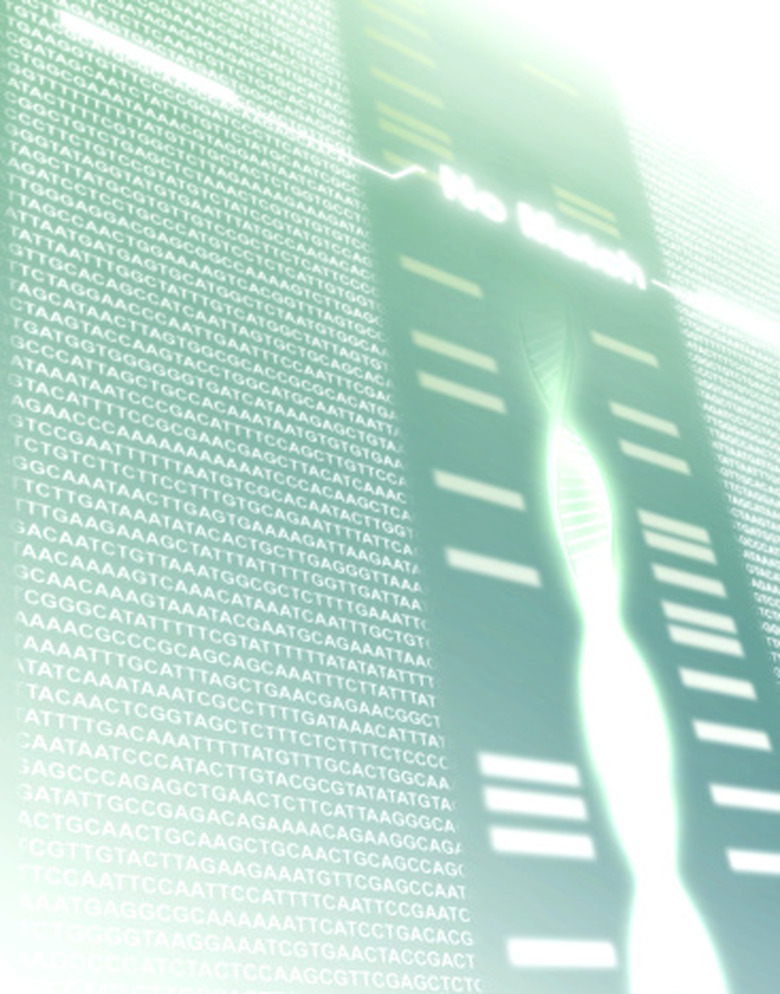How To Interpret Agarose Gel
Once you've run DNA samples on an agarose gel and taken a picture, you can save the picture for later on, at which point you can analyze the results and interpret them. The kinds of things you're looking for will depend on the nature of your experiment. If you're doing DNA fingerprinting, for example, you'll want to compare the size of pieces of DNA from two samples — from the suspect and from a crime scene sample, perhaps. If you're working with plasmids from bacteria, by contrast, you might need to make sure the plasmid contains the insert. Consequently, how you interpret your gel will depend in part on the experiment you did. Nonetheless, there are some general rules you can apply.
Step 1
Starting from the top of the picture, measure the distance to each band in the "standards" lane of your gel (aka the ladder). The standards lane contains DNA pieces whose size is already known, so you should already know the size of each prior to beginning your experiment. Also measure the distance travelled by the bands in each of the sample lanes.
Step 2
Divide the distance each standard and each band in the samples travelled by the distance to the bottom of the gel. The result is called the relative mobility. You can use the spreadsheet program to do the arithmetic for you if it will make this step quicker.
Step 3
Enter the relative mobility and size of each standard into your spreadsheet program, then use your spreadsheet program's graphing tool to create a graph of this data with relative mobility on the x-axis and size on the y.
Step 4
Fit a line to the graph using nonlinear regression. Consult your spreadsheet program's Help section if you need to know how to do this. You should end up with an equation, perhaps one similar to the following:
y = (0.3) x^-2.5
Note that x here will be the relative mobility, while y is the size. Also note that your equation may have completely different numbers for the exponent and the coefficient — this equation is just provided as a hypothetical example.
Step 5
Take the relative mobility for the bands from your sample and plug it in as x to calculate the size of the DNA pieces in the sample bands.
Suppose the equation derived by your spreadsheet program was indeed y = (0.3) x^-2.5, and the relative mobility of a particular sample band was 0.68. Substituting 0.68 into your equation, you find the following:
y = (0.3) (0.68)^-2.5
Using your calculator, you raise 0.68 to the -2.5 and find the following:
y = (0.3) (2.62)
y = 0.786
which would then be the estimated size in kilobases of the DNA in one of the bands from your sample.
Plasmids
Step 1
Note that you may or may not need to use the instructions in this section. Agarose gel electrophoresis is often used to confirm that a plasmid contains a given insert. If you're not working with plasmids, you can skip this section. If you are, however, you can follow these instructions.
Step 2
Notice that if you are working with uncut or nicked plasmids, you can not estimate the size using the procedure from section 1 above. That's because uncut and nicked plasmids migrate at different rates from linear DNA.
Step 3
Compare the number of bands in each lane. Recall that a restriction enzyme cuts DNA at sites where a given sequence called the restriction site occurs. If a sample was treated with TWO restriction enzymes, a band for the insert and a band for the remainder of the plasmid should both be present. That's because the insert will be flanked by two restriction sites, each for a different enzyme, so cuts at both of these sites will free the insert from the plasmid. A cut at only one site, by contrast, will convert the plasmid to linear DNA. A sample cut with no restriction enzymes or one restriction enzyme, then, should feature a single band, while a sample cut with two restriction enzymes should feature two bands.
Step 4
Look out for bands created by nicked plasmid DNA. A nicked plasmid has a cut in a single strand only, so it migrates more slowly than a cut plasmid. Cut plasmids in turn migrate more slowly than uncut DNA.
Step 5
Estimate the size of the insert using the procedure described in Section 1 and determine whether it matches your expectations (which will vary depending on the experiment.)
Things Needed
- Pencil
- Paper
- Spreadsheet program
- Picture of your gel
- Ruler
References
- "Biochemical Techniques, Laboratory Manual"; Aaron Coleman, et al.; 2010
Cite This Article
MLA
Brennan, John. "How To Interpret Agarose Gel" sciencing.com, https://www.sciencing.com/interpret-agarose-gel-8488220/. 24 April 2017.
APA
Brennan, John. (2017, April 24). How To Interpret Agarose Gel. sciencing.com. Retrieved from https://www.sciencing.com/interpret-agarose-gel-8488220/
Chicago
Brennan, John. How To Interpret Agarose Gel last modified March 24, 2022. https://www.sciencing.com/interpret-agarose-gel-8488220/
